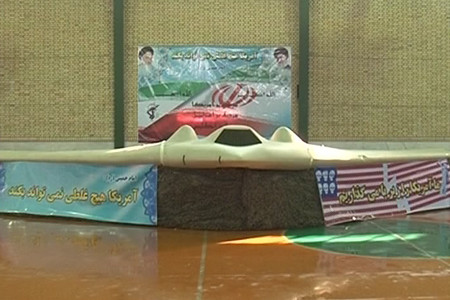
US Drone shot down over the Islamic Republic of Iran. Washington uses these weapons to kill thousands in Africa, the Middle East and Central Asia. Many are opposed to the use of these weapons., a photo by Pan-African News Wire File Photos on Flickr.
latimes.com/news/nationworld/world/la-fg-obama-drone-20111213,0,6677845.story
latimes.com
U.S. asks Iran to return spy drone
The Defense secretary says he doesn't expect Tehran to comply. Iran says it is planning to clone and mass produce the bat-winged craft for use against its enemies.
By David S. Cloud and Ken Dilanian
Los Angeles Times
9:21 PM PST, December 12, 2011
Reporting from Washington
The Obama administration has sent a formal diplomatic request asking Iran to return the radar-evading drone aircraft that crashed on a CIA spying mission this month, but U.S. officials say they don't expect Iran will comply.
"We have asked for it back," Obama said Monday at a news conference in Washington with Iraqi Prime Minister Nouri Maliki. "We'll see how the Iranians respond."
His comments marked the first public confirmation that the RQ-170 Sentinel drone now in Iranian hands is a U.S. aircraft, though U.S. officials privately acknowledged that in recent days. Iran has claimed it downed the stealthy surveillance drone, but U.S. officials say it malfunctioned.
Capture of the futuristic-looking unmanned spy plane has provided Tehran with a propaganda windfall. The government announced that it planned to clone and mass produce the bat-winged craft for use against its enemies.
The embarrassing loss of the CIA drone has focused attention on the use of an air base in western Afghanistan over the last several years to launch aerial surveillance missions against suspected nuclear facilities and other targets in neighboring Iran.
Defense Secretary Leon E. Panetta called the U.S. request for return of the drone "appropriate," but he acknowledged that Iran's government, which last week lodged a formal complaint with the United Nations about the U.S. spy plane violating its airspace, was unlikely to send it back.
"I don't expect that will happen, but I think it's important to make that request," Panetta told reporters traveling with him aboard a U.S. military aircraft.
Officials declined to say how the U.S. filed the formal request. Washington doesn't have diplomatic relations with Tehran, and normally communicates through the Swiss government. Mark Toner, a State Department spokesman, refused to discuss the issue, saying he would not comment on intelligence matters.
Iranian state media reported Monday that Iranian experts were recovering valuable data from the drone, which appeared relatively intact in photographs released by Iran, and were trying to reverse-engineer its unique capabilities.
Parviz Sarvari, head of the Iranian parliament's national security and foreign policy committee, said that Iran is "in the final steps of breaking into the aircraft's secret code."
"The findings will be used to support our accusations against the U.S.," Sarvari said in comments reported by the state-run Al Alam news channel.
Amir Ali Hajizadeh, who commands the Revolutionary Guard's Aerospace Forces, told the semiofficial Fars News Agency that the aircraft "was downed in Iran with minimum damage," according to Israel's Haaretz newspaper.
U.S. officials said they don't believe Iran's scientists can reverse-engineer the craft's stealth design and skin coating, which help it evade detection on radar. But they expressed concern that Iran may figure out the drone's flight path, and thus learn the CIA's surveillance targets inside Iran.
U.S. officials also are concerned that Iran could offer the drone to China or other U.S. rivals or adversaries that are building their own stealth aircraft, including drones.
Panetta said it was unclear how much Iran could glean from the recovered spy plane, or what condition it was in.
Iran said it downed the drone about 140 miles inside Iran through electronic warfare, suggesting hacking or signal jamming. U.S. officials say the aircraft malfunctioned and went down on its own.
david.cloud@latimes.com
ken.dilanian@latimes.com
Copyright © 2011, Los Angeles Times
No comments:
Post a Comment